Behringer DSP1200P User Manual
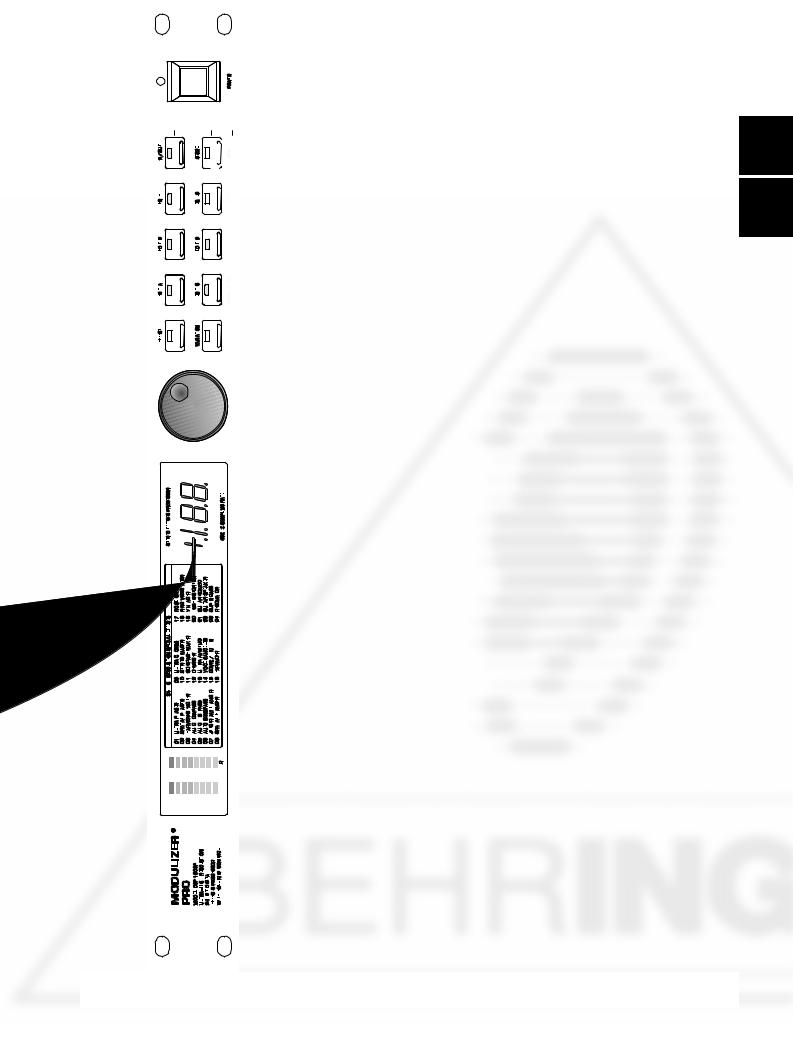
User´s Manual
Bedienungsanleitung
E
D
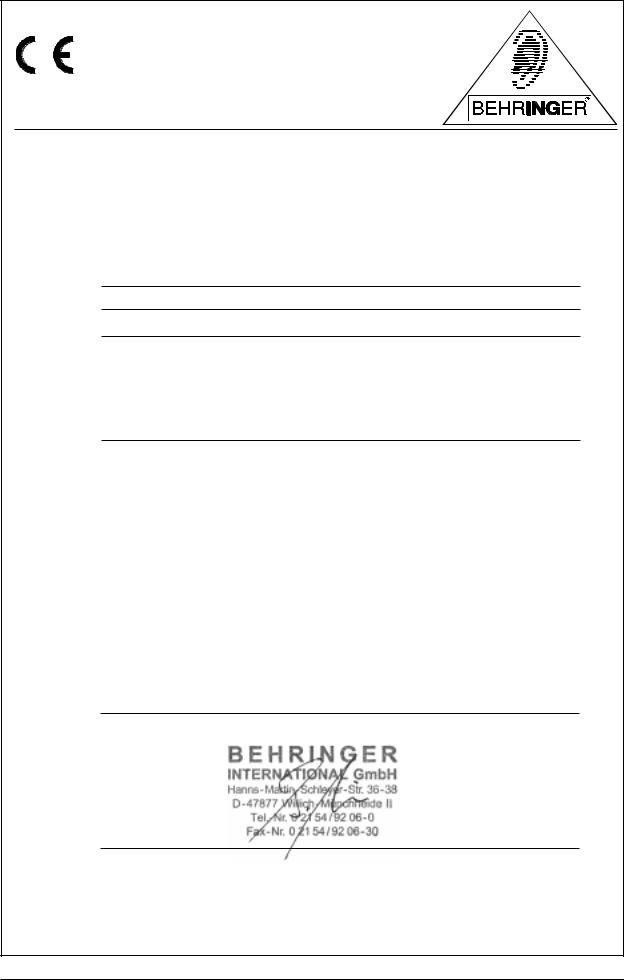
EG-Declaration of Conformity
Spezielle Studiotechnik GmbH
acc. to the Directives 89/336/EWG and 73/23/EWG
We, BEHRINGER INTERNATIONAL GmbH
Hanns-Martin-Schleyer-Straße 36-38
D - 47877 Willich
Name and address of the manufacturer or the introducer of the product on the market who is established in the EC
herewith take the sole responsibility to confirm that the product:
MODULIZER PRO DSP1200P
Type designation and, if applicable, Article-No
which refers to this declaration, is in accordance with the following standards or standardized documents:
ξ EN 60065 |
ξ EN 61000-3-2 |
ξ EN 55020 |
ξ EN 61000-3-3 |
ξ EN 55013 |
ξ EN 55022 |
The following operation conditions and installation arrangements have to be presumed:
acc. to Operating Manual
B. Nier, President |
Willich, 01.11.1998 |
Name, address, date and legally binding signature of the person responsible |
|
2
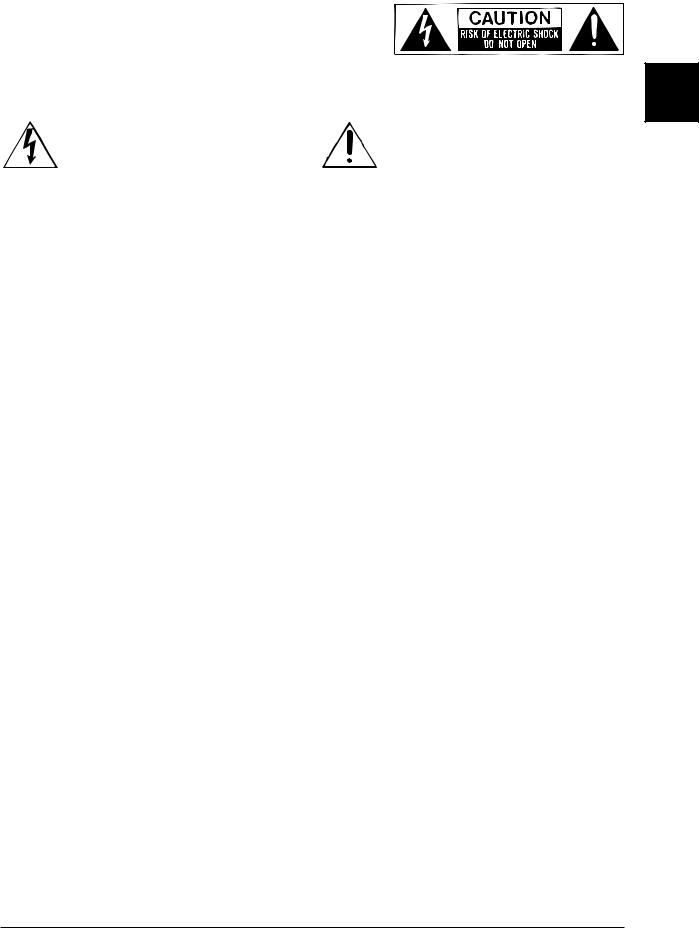
SAFETY INSTRUCTIONS
CAUTION: To reduce the risk of electrical shock, do not remove the cover (or back). No user serviceable parts inside; refer servicing to qualified personnel.
WARNING: To reduce the risk of fire or electrical shock, do not expose this appliance to rain or moisture.
This symbol, wherever it appears, alerts you to the presence of uninsulated dangerous voltage inside the enclosure - voltage that may be sufficient to constitute a risk of shock.
E
This symbol, wherever it appears, alerts you to important operating and maintenance instructions in the accompanying literature. Read the manual.
DETAILED SAFETY INSTRUCTIONS:
All the safety and operation instructions should be read before the appliance is operated.
Retain Instructions:
The safety and operating instructions should be retained for future reference.
Heed Warnings:
All warnings on the appliance and in the operating instructions should be adhered to.
Follow instructions:
All operation and user instructions should be followed.
Water and Moisture:
The appliance should not be used near water (e.g. near a bathtub, washbowl, kitchen sink, laundry tub, in a wet basement, or near a swimming pool etc.).
Ventilation:
The appliance should be situated so that its location or position does not interfere with its proper ventilation. For example, the appliance should not be situated on a bed, sofa rug, or similar surface that may block the ventilation openings, or placed in a built-in installation, such as a bookcase or cabinet that may impede the flow of air through the ventilation openings.
Heat:
The appliance should be situated away from heat sources such as radiators, heat registers, stoves, or other appliance (including amplifiers) that produce heat.
Power Source:
The appliance should be connected to a power supply only of the type described in the operating instructions or as marked on the appliance.
Grounding or Polarization:
Precautions should be taken so that the grounding or polarization means of an appliance is not defeated.
Power-Cord Protection:
Power supply cords should be routed so that they are not likely to be walked on or pinched by items placed upon or against them, paying particular attention to cords and plugs, convenience receptacles and the point where they exit from the appliance.
Cleaning:
The appliance should be cleaned only as recommended by the manufacturer.
Non-use Periods:
The power cord of the appliance should be unplugged from the outlet when left unused for a long period of time.
Object and Liquid Entry:
Care should be taken so that objects do not fall and liquids are not spilled into the enclosure through openings.
Damage Requiring Service:
The appliance should be serviced by qualified service personnel when:
-The power supply cord or the plug has been damaged; or
-Objects have fallen, or liquid has been spilled into the appliance; or
-The appliance has been exposed to rain; or
-The appliance does not appear to operate normally or exhibits a marked change in performance; or
-The appliance has been dropped, or the enclosure damaged.
Servicing:
The user should not attempt to service the appliance beyond that is described in the Operating Instructions. All other servicing should be referred to qualified service personnel.
3

MODULIZER PRO |
|
|
|||||||
Ultra-high performance Digital Multi-Effects Processor powered by a 24-bit high-speed Digital Signal Processor (DSP) |
|
||||||||
|
|
|
|
|
|
|
DSP1200P |
|
|
sCutting |
edge |
effects |
such |
as |
3D |
Processor, |
Stereo |
Imager, |
Lo-Fi, |
|
Canceler etc. |
|
|
|
|
|
|
|
|
|
|
|
|
|
|
|
www.behringer.de) |
|
|
4 |
|
|
|
|
|
|
|
|
|

FOREWORD
Dear Customer,
Welcome to the team of MODULIZER PRO users and thank you very much for expressing your confidence in |
|
BEHRINGER products by purchasing this unit. |
E |
It is one of my most pleasant tasks to write this letter to you, because it is the culmination of many months of |
|
hard work delivered by our engineering team to reach a very ambitious goal: making an outstanding device that |
|
will become a standard tool used by studios and P.A. companies. The task to design the MODULIZER PRO |
|
|
|
certainly meant a great deal of responsibility, which we assumed by focusing on you, the discerning user and |
|
musician. It also meant a lot of work and night shifts to accomplish this goal. But it was fun, too. Developing a |
|
product usually brings a lot of people together, and what a great feeling it is when everybody who participated |
|
in such a project can be proud of what we’ve achieved. |
|
It is our philosophy to share our joy with you, because you are the most important member of the BEHRINGER |
|
family. With your highly competent suggestions for new products you’ve greatly contributed to shaping our |
|
company and making it successful. In return, we guarantee you uncompromising quality (manufactured under |
|
ISO9000 certified management system) as well as excellent technical and audio properties at an extremely |
|
favorable price. All of this will enable you to fully unfold your creativity without being hampered by budget |
|
constraints. |
|
We are often asked how we can make it to produce such high-grade devices at such unbelievably low prices. |
|
The answer is quite simple: it’s you, our customers! Many satisfied customers means large sales volumes |
|
enabling us to get better conditions of purchase for components, etc. Isn’t it only fair to pass this benefit back |
|
to you? Because we know that your success is our success, too! |
|
I would like to thank all people whose help on “Project MODULIZER PRO“ has made it all possible. Everybody |
|
has made very personal contributions, starting from the designers of the unit via the many staff members in our |
|
company to you, the user of BEHRINGER products. |
|
My friends, it’s been worth the trouble!
Thank you very much,
Uli Behringer
5

TABLE OF CONTENTS
1. INTRODUCTION..................................................................................................................... |
7 |
||
1.1 |
The design concept ......................................................................................................................... |
7 |
|
1.2 |
Before you begin ............................................................................................................................. |
8 |
|
1.3 |
Control elements ............................................................................................................................ |
9 |
|
|
1.3.1 Front panel control elements ................................................................................................. |
9 |
|
|
1.3.2 |
Key combinations ............................................................................................................... |
10 |
|
1.3.3 |
Back panel .......................................................................................................................... |
11 |
1.4 |
The effect algorithms ..................................................................................................................... |
12 |
|
2. OPERATION .......................................................................................................................... |
20 |
|
2.1 |
Effects structure............................................................................................................................ |
20 |
2.2 |
Selecting presets .......................................................................................................................... |
21 |
2.3 |
Editing programs ........................................................................................................................... |
21 |
2.4 |
Saving programs ........................................................................................................................... |
21 |
2.5 |
MIDI control................................................................................................................................... |
21 |
|
2.5.1 “Modulation”-controller ......................................................................................................... |
23 |
3. APPLICATIONS ..................................................................................................................... |
23 |
|
3.1 |
Level setting .................................................................................................................................. |
23 |
3.2 |
Using the MODULIZER PRO in the aux bus .................................................................................. |
23 |
3.3 |
Using the MODULIZER PRO in the insert path .............................................................................. |
24 |
3.4 |
Using the MODULIZER PRO as an effects device for instruments ................................................. |
25 |
3.5 |
Using the MODULIZER PRO in a MIDI system ............................................................................. |
26 |
3.6 |
Saving data via MIDI ...................................................................................................................... |
27 |
4. TECHNICAL BACKGROUND .............................................................................................. |
27 |
||
4.1 |
Digital audio processing ................................................................................................................ |
27 |
|
4.2 |
Reverberation and reflection .......................................................................................................... |
28 |
|
4.3 |
Audio dynamics ............................................................................................................................ |
29 |
|
|
4.3.1 Noise as a physical phenomenon ....................................................................................... |
30 |
|
|
4.3.2 What are audio dynamics? ................................................................................................. |
30 |
|
|
4.3.3 |
Compressors/limiters .......................................................................................................... |
31 |
|
4.3.4 |
Expanders/noise-gates ....................................................................................................... |
32 |
4.4 |
Artificial harmonics generation ...................................................................................................... |
32 |
|
4.5 |
Tube technology............................................................................................................................ |
32 |
|
5. INSTALLATION ..................................................................................................................... |
33 |
|
5.1 |
Rack mounting .............................................................................................................................. |
33 |
5.2 |
Mains connection .......................................................................................................................... |
33 |
5.3 |
Audio connections ........................................................................................................................ |
34 |
5.4 |
MIDI connections .......................................................................................................................... |
35 |
5.5 |
Operating level switch ................................................................................................................... |
36 |
6. |
APPENDIX ............................................................................................................................. |
36 |
|
|
6.1 |
Parameter overview ....................................................................................................................... |
36 |
|
6.2 |
Variation table ............................................................................................................................... |
37 |
|
6.3 |
MIDI implementation ..................................................................................................................... |
38 |
|
6.4 |
Default settings ............................................................................................................................. |
39 |
|
6.5 |
Preset parameters ........................................................................................................................ |
40 |
|
6.6 |
Specifications ............................................................................................................................... |
41 |
7. |
WARRANTY .......................................................................................................................... |
42 |
|
6

1. INTRODUCTION
With the BEHRINGER MODULIZER PRO you have acquired an extremely powerful and versatile multi-effects processor, which besides first-class modulation effects is equipped with many other algorithms. Despite the large number of effects, variations, and editable parameters, the DSP1200P is easily and intuitively operated owing to its logically structured layout.
Filters have been enjoying a renaissance during the past few years and not only in dance music. We have |
E |
implemented a variety of resonant filter types in the MODULIZER PRO. For example, you can use amplitude- |
|
controlled and LFO filters giving your sounds an interesting color. Since each filter parameter is MIDI-control- |
|
lable in manual mode, you can even record song-related filter changes in a sequencer program and play them |
|
back later on. So, even timing-based filter settings can be achieved. |
|
So-called lo-fi effects simulating, for example click sounds produced by vinyl records or the noise of older tape |
|
recordings, are particularly suitable for techno, house and hip-hop productions. »Space« effects can be pro- |
|
duced with the Ring Modulator which also doubles as a separate sound generator. |
|
For guitars, we combined specific distortion and preamp variants with speaker simulations that enable you to |
|
create an excellent sound even without actually using a speaker cabinet during the recording session. But the |
|
MODULIZER PRO also functions as a multi-effect processor for guitar combo or rack-mount amps producing, |
|
for example phaser and various wah-wah and auto-wah effects. |
|
To give you direct access to all modifiable parameters, the MODULIZER PRO has four edit control elements |
|
next to the VARIATION button that allow for editing these parameters directly and intuitively. Having selected |
|
a parameter you can change its value with the jog wheel. Of course, all effect parameters are MIDI-controllable |
|
in real time. |
|
Additionally, the DSP1200P includes such “hip” algorithms as lo-fi, tube distortion and ring modulation. Please read this manual carefully to be able to fully exploit the effects and features of the innovative BEHRINGER effect algorithms implemented in the MODULIZER PRO.
+The MODULIZER PRO can distort signals to a great extent. When you are scrolling through the presets, you may find programs with considerably differing output levels. Always reduce the volume of subsequent devices (e.g. amps, speakers, etc.) to a minimum level to protect these devices against possible damage.
Despite the enormous and compute-intensive work to be done in the DSP1200P by a “dual-engine” 24-bit processor, the MODULIZER PRO can be operated easily and conveniently. All parameter changes can be made with the jog wheel (rotary control). 100 memory locations are available.
A very special feature are the high-low filters which can be edited freely. They are available for direct selection in each preset. Use the filters to adapt the “sound” of your presets to the room acoustics, which is particularly useful in live situations when every second counts.
+The following operational manual will introduce you to the BEHRINGER MODULIZER PRO and its various functions. After reading the manual carefully, make sure it is always on hand for future reference.
1.1 The design concept
The MODULIZER PRO is a mighty tool for the processing of audio signals. You can use it like a real musical instrument and owing to the direct access to all major parameters, which are also controllable via MIDI, your imagination is the only limit. We recommend that you read the descriptions of all effects thoroughly, so that you can make efficient use of the MODULIZER PRO’s vast sound potential. Or to use a wise old saying from the studio scene: “The best device is only as good as the person using it!”
With its clearly structured user interface the DSP1200P invites you to try and experiment with the preset effects programs which we programmed very carefully and right down to the last detail. Select them simply by rotating the encoder (jog wheel). Once selected, a preset is activated only after a pause of two seconds (i.e. when the point in the display disappears).
+Presets selected via MIDI, however, are activated without delay!
The MODULIZER PRO not only boasts a logic and straightforward user interface, its technical features too are quite impressive. Pro-level signal processing is ensured by the following components:
1. INTRODUCTION |
7 |

sExtremely low-noise and high-precision 20-bit AD/DA converters.
sA professional 46 kHz sampling rate guarantees high signal resolution with a frequency response of 20 Hz through 20 kHz.
sThe 24-bit processor provides lots of computing power (dual-engine software) for real-time effect modulation.
sLike all BEHRINGER products, the MODULIZER PRO uses exclusive top-quality components and circuits.
With its complete MIDI implementation the DSP1200P can be integrated in any MIDI system. A MIDI software editor will soon be available and enables you to program the MODULIZER PRO from your personal computer, and the MIDI interface allows for transmitting data from the DSP1200P and store them on an external storage medium. For example, you can use sys-ex dumps to send all presets and settings to your sequencer program and reload them from there whenever you want.
The philosophy behind BEHRINGER products guarantees a no-compromise circuit design and employs the best choice of components. Top-quality 20-bit AD/DA converters which belong to the best components available owing to its outstanding specifications and excellent sonic characteristics. A 24-bit DSP is used as the heart of the MODULIZER PRO. It performs the precise calculations needed for the processing of the complex algorithms. Additionally, the MODULIZER PRO uses metal-film resistors and capacitors with very tight tolerances, high-grade switches, low-noise operational amplifiers (type 4580) as well other selected components.
The MODULIZER PRO DSP1200P uses SMD technology (Surface Mounted Device). These subminiature components adapted from aerospace technology allow for an extreme packing density to further improve the overall reliability. Additionally, the unit is manufactured in compliance with the ISO9000 certified management system.
1.2 Before you begin
Your BEHRINGER MODULIZER PRO was carefully packed in the factory and the packaging was designed to protect the unit from rough handling. Nevertheless, we recommend that you carefully examine the packaging and its contents for any signs of physical damage, which may have occurred in transit.
+If the unit is damaged, please do not return it to us, but notify your dealer and the shipping company immediately, otherwise claims for damage or replacement may not be granted. Shipping claims must be made by the consignee.
The BEHRINGER MODULIZER PRO fits into one standard 19" rack unit of space (1 3/4"). Please allow at least an additional 4" depth for the connectors on the back panel.
+Be sure that there is enough space around the unit for cooling and please do not place the MODULIZER PRO on high temperature devices such as power amplifiers etc. to avoid overheating.
The mains connection of the MODULIZER PRO is made by using a mains cable and a standard IEC receptacle. It meets all of the international safety certification requirements. Please make sure that all units have a proper ground connection.
+Before you connect your MODULIZER PRO to the mains, please make sure that your local voltage matches the voltage required by the unit! (see chapter 5 for details)
+Please ensure that only qualified persons install and operate the MODULIZER PRO. During installation and operation the user must have sufficient electrical contact to earth. Electrostatic charges might affect the operation of the MODULIZER PRO!
As a standard the audio inputs and outputs on the BEHRINGER MODULIZER PRO are fully balanced. If possible, connect the unit to other devices in a balanced configuration to allow for maximum interference immunity. The automatic servo function detects unbalanced connections and compensates the level difference automatically (6 dB correction).
The MIDI links (IN/OUT/THRU) are made over standardized DIN patch cords. The data communication is isolated from ground by opto couplers.
8 |
1. INTRODUCTION |
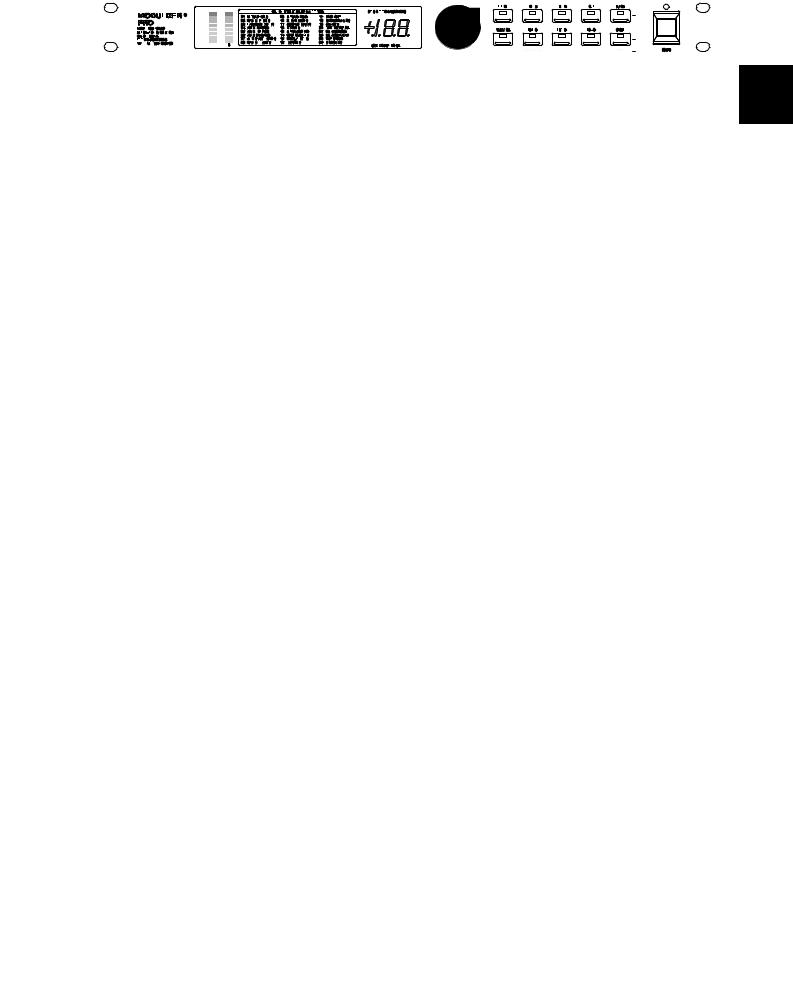
1.3Control elements
E
9
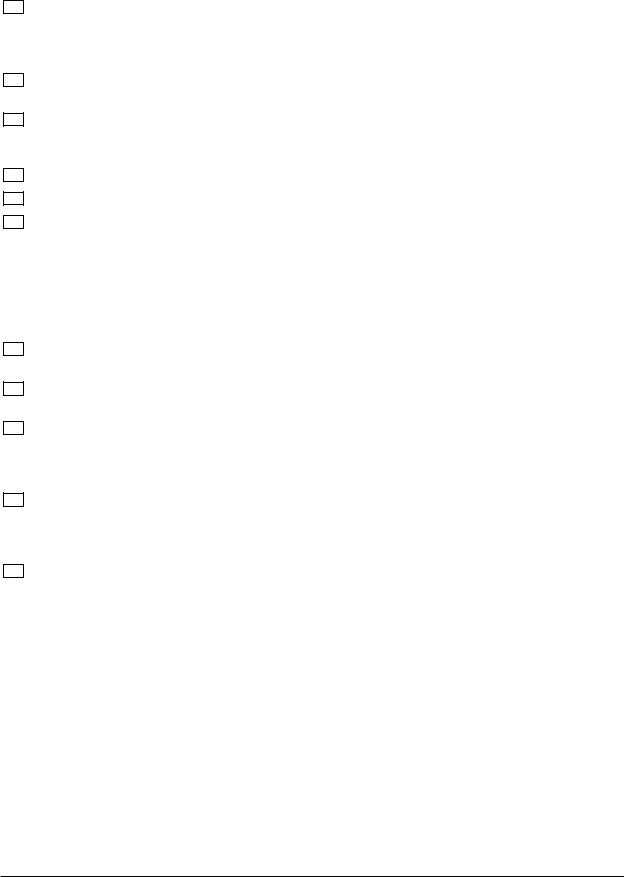
+As long as none of the edit functions to the right of the jog wheel has been selected, you can use the wheel to select a program directly, which is shown by a dot lighting up in the display. While this dot is on, you can select a program though its settings will not take immediate effect. When the jog wheel has not been touched for one second, the LED in the display disappears and the program is loaded.
5 Use the EFFECT key to directly select one of the 24 basic effect algorithms with the jog wheel.
+Whenever a new algorithm is selected, all parameters are reset to default values.
6The VARIATION key allows you to select the most important parameter of each algorithm, for example LFO speed for algorithm 1, i.e. a phaser then can be modified with the jog wheel.
7In each preset you can edit at least three and mostly four parameters in addition to the preset VARIATION. Use the EDIT A key to select the first parameter. The exact parameter assignment can be seen from the parameter list printed on the enclosure top and in the appendix.
8Use the EDIT B key to select another parameter which is to be altered.
9With the EDIT C key you can select the third parameter.
10 The EDIT D key allows you to modify the fourth parameter if one is given.
+With modulation effects, when the LFO is set to zero, the modulation stops and can be set manually or via MIDI. To adjust it manually press EDIT A and EDIT C simultaneously. To control it via MIDI you can use controller # 56. If control send is activated, the MODULIZER PRO sends the actual LFO state, again using controller # 56. When the LFO is started again it begins on that same value. This applies to all effect algorithms in which a LFO is used, except the Ultra Chorus.
11To give your programs the finishing touch, the MODULIZER PRO incorporates two filters. Use the EQ HI key to raise or lower the high-frequency portions of the effect program.
12The EQ LO key activates a filter which processes the low-frequency portions of your preset. Pressing both EQ LO and EQ HI will activate the Mix-Mode (See next paragraph).
13The IN/OUT key enables you to bypass the DSP1200P. The green LED lights up as soon as the MODULIZER PRO is activated. Depending on the Mix mode adjusted, this key can also be used to activate the Mute function. Additionally, the green LED starts flashing whenever MIDI data is being received.
14Use the STORE key to save the edited program to a user preset as shown in the display. 100 user presets are available on the DSP1200P. Press the key once to select a memory location (number), then press it again to store the preset. Pressing both IN/OUT and STORE will put the MODULIZER PRO in MIDI mode (see next paragraph).
15Use the POWER switch to switch the MODULIZER PRO on or off.
1.3.2Key combinations
To protect the DSP1200P against user errors, three important edit commands have been implemented as a series of key combinations. For example, in normal operating modes, the presets cannot be reset to their factory defaults, so as to keep your own programs safe. Please proceed as follows to reinitialize the preset default settings:
sPress and keep the keys EFFECT and STORE before powering up the MODULIZER PRO. Then switch on the DSP1200P and keep the two keys pressed for about one second. The programs are counted up and reset to their original default settings.
The MODULIZER PRO provides two methods to mix the input and the effect signals (External Mix and Internal Mix mode). Select External Mix mode to use the DSP1200P with a mixing console: in this mode all presets are set to 100% effect intensity, i.e. you can use the aux return busses of your console to add the processed signal to the original signal. In External Mix mode the IN/OUT key is used to bypass the unit. Here’s how to enter Mix Extern mode:
sWith the unit switched on, press the Mix mode key combination, i.e. the keys EQ LO and EQ HI.
10 |
1. INTRODUCTION |
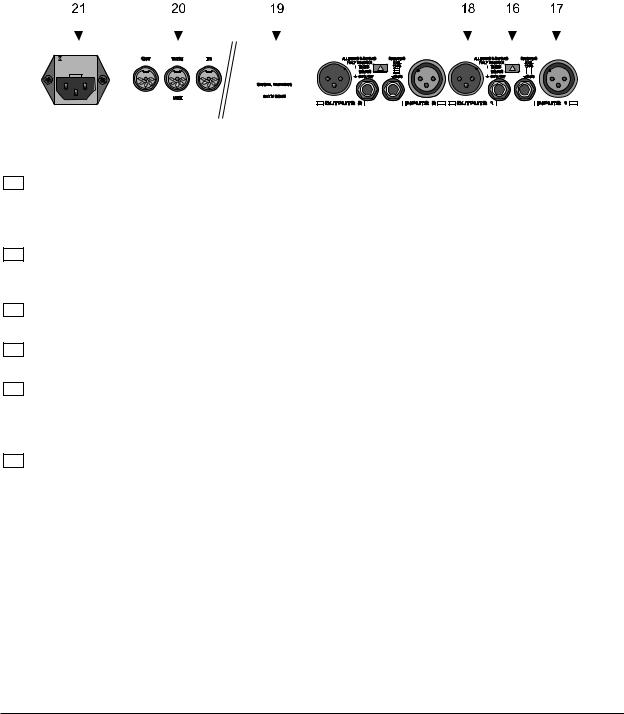
The MODULIZER PRO enters Mix mode. When the display reads two dashes, the DSP1200P is in External Mix mode, and when a figure is read, Internal Mix mode is selected. To toggle between the two modes, simply press both EQ keys for about 1 second.
In Internal Mix mode you can use the jog wheel to freely select the effect intensity in each preset within a range from 0% to 100%, a highly useful feature, for instance, to insert the DSP1200P in the effect loop of a guitar amp. Good results can be achieved with settings between 20% and 50%.
Another key combination can be used to enter MIDI mode. With the MODULIZER PRO switched on, proceed |
E |
|||||||||||||||||||||||||||||||||||||||||||||||
as follows: |
||||||||||||||||||||||||||||||||||||||||||||||||
s |
Press and hold the keys IN/OUT and STORE for about two seconds, the DSP1200P automati- |
|||||||||||||||||||||||||||||||||||||||||||||||
|
cally enters MIDI mode. Use the IN/OUT key to step through the various MIDI parameters. Press |
|
||||||||||||||||||||||||||||||||||||||||||||||
|
|
|||||||||||||||||||||||||||||||||||||||||||||||
|
any other key to quit MIDI mode. |
|
||||||||||||||||||||||||||||||||||||||||||||||
1.3.3 |
Back panel |
|
||||||||||||||||||||||||||||||||||||||||||||||
|
|
|
|
|
|
|
|
|
|
|
|
|
|
|
|
|
|
|
|
|
|
|
|
|
|
|
|
|
|
|
|
|
|
|
|
|
|
|
|
|
|
|
|
|
|
|
|
|
|
|
|
|
|
|
|
|
|
|
|
|
|
|
|
|
|
|
|
|
|
|
|
|
|
|
|
|
|
|
|
|
|
|
|
|
|
|
|
|
|
|
|
|
|
|
|
|
|
|
|
|
|
|
|
|
|
|
|
|
|
|
|
|
|
|
|
|
|
|
|
|
|
|
|
|
|
|
|
|
|
|
|
|
|
|
|
|
|
|
|
|
|
|
|
|
|
|
|
|
|
|
|
|
|
|
|
|
|
|
|
|
|
|
|
|
|
|
|
|
|
|
|
|
|
|
|
|
|
|
|
|
|
|
|
|
|
|
|
|
|
|
|
|
|
|
|
|
|
|
|
|
|
|
|
|
|
|
|
|
|
|
|
|
|
|
|
|
|
|
|
|
|
|
|
|
|
|
|
|
|
|
|
|
|
|
|
|
|
|
|
|
|
|
|
|
|
|
|
|
|
|
|
|
|
|
|
|
|
|
|
|
|
|
|
|
|
|
|
|
|
|
|
|
|
|
|
|
|
|
|
|
|
|
|
|
|
|
|
|
|
|
|
|
|
|
|
|
|
|
|
|
|
|
|
|
|
|
|
|
|
|
|
|
|
|
|
|
|
|
|
|
|
|
|
|
|
|
|
|
|
|
|
|
|
|
|
|
|
|
|
|
|
|
|
|
|
|
|
|
|
|
|
|
|
|
|
|
|
|
|
|
|
|
|
|
|
|
|
|
|
|
|
|
|
|
|
|
|
|
|
|
|
|
|
|
|
|
|
|
|
|
|
|
|
|
|
|
|
|
|
|
|
|
|
|
|
|
|
|
|
|
|
|
|
|
|
|
|
|
|
|
|
|
|
|
|
|
|
|
|
|
|
|
|
|
|
|
|
|
|
|
|
|
|
|
|
|
|
|
|
|
|
|
|
|
|
|
|
|
|
|
|
|
|
|
|
|
|
|
|
|
|
|
|
|
|
|
|
|
|
|
|
|
|
|
|
|
|
|
|
|
|
|
|
|
|
|
|
|
|
|
|
|
|
|
|
|
|
|
|
|
|
|
|
|
|
|
|
|
|
|
|
|
|
|
|
|
|
|
|
|
|
|
|
|
|
|
|
|
|
|
|
|
|
|
|
|
|
|
|
|
|
|
|
|
|
|
|
|
|
|
|
|
|
|
|
|
|
|
|
|
|
|
|
|
|
|
|
|
|
|
|
|
|
|
|
|
|
|
|
|
|
|
|
|
|
|
|
|
|
|
|
|
|
|
|
|
|
|
|
|
|
|
|
|
|
|
|
|
|
|
|
|
|
|
|
|
|
|
|
|
|
|
|
|
|
|
|
|
|
|
|
|
|
|
|
|
|
|
|
|
|
|
|
|
|
|
|
|
|
|
|
|
|
|
|
|
|
|
|
|
|
|
|
|
|
|
|
|
|
|
|
|
|
|
|
Fig. 1.4: Back panel connectors and control elements
16Use the OPERATING LEVEL switch to adapt the MODULIZER PRO to different operating levels. You can select a -10 dBV semi-pro level used for home recording and a +4 dBu level used in professional studios. The level indicators on the front panel are automatically adapted to read the selected nominal level, i.e. an optimum operating range of the meters is always guaranteed.
17These are the MODULIZER PRO’s analog INPUTS. The MODULIZER PRO has both XLR and jack inputs and outputs. Each XLR and jack set are wired parallel and can be used either balanced and unbalanced.
18These are the MODULIZER PRO’s analog OUTPUTS. Also on balanced or unbalanced XLR or TRS jacks.
19These are the MODULIZER PRO’s MIDI connectors (MIDI OUT / THROUGH / IN). Via these connectors total remote control is possible.
20Please take the time to make shure that the SERIAL NUMBER is printed correctly in the space provided on the enclosed Warranty Registration Card. Put the instruction manual in a safe place and return the completed Warranty Registration Card to us within 14 days of purchase, making sure that the dealer stamphas been acquired.
21This is the MAINS CONNECTOR / FUSE HOLDER / VOLTAGE SELECTOR. Before you connect the unit, please make sure that the displayed voltage corresponds to your Mains supply. Please note that the AC voltage selection is defined by the position of the Fuse Holder. If you intend to change the operating voltage, remove the Fuse Holder and turn it by 180 degrees before you reinsert it. Matching the two markers monitors the selected voltage. Please note that, depending on the mains voltage supplied to the unit, the correct fuse type and rate must be installed (see chapter 6.5 “SPECIFICATIONS”). Please use the enclosed mains cable to connect the unit to the mains power supply.
+Please note that not all appliances can be used with different mains voltage ratings. Please check the description on the back of the unit and the box.
1. INTRODUCTION |
11 |
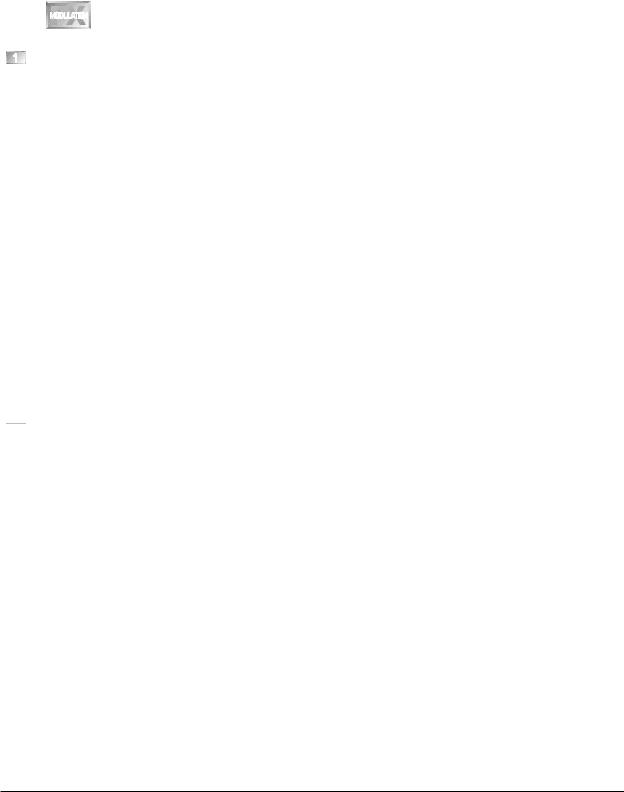
1.4 The effect algorithms
In a digital effects device all effect programs are based on algorithms computed by a Digital Signal Processor (DSP). How does this work? A DSP can perform an enormous number of binary computations in a minimum amount of time. The binary computations that are used to generate an effect as part of a program are determined by a so-called algorithm which represents a rule for computing numerical values that are exactly specified for each effect type. For example, tube distortion algorithms differ from chorus algorithms in their programming. Plainly speaking: each effect is based on a specific algorithm which processes the input signal (previously converted from analog to digital). All of this work is done by the DSP. Once the effect has been generated and added to the input signal, the digital music signal is converted back to analog by means of a D/A converter.
Ultra Phaser
A phaser is one of the MODULIZER PRO’s classic modulation effects. It is quite popular for guitar sounds and keyboard pads, but was also extensively used during the 70’s for other instruments, such as electric pianos.
From a technical point of view, a phaser is a modulation effect producing a multi-stage phase shift between the direct and effect signals, which results in a modulated comb filter effect. Depending on how they are set up, phasers can be used to slightly modulate or heavily distort the signal spectrum. Consequently, the sound they produce is a bit like that of a regularly modulated filter. Although most often used as a single-instrument effect, there are well-known examples when phasers are used on mix signals, so do not hesitate to experiment with it.
The parameters of the phaser:
VARIATION: “Speed”: determines the LFO speed between 0 (see following Note) and 9.9 Hz. EDIT A: “Intensity”: adjusts the number of all-pass filters.
EDIT B: “Depth”: is used to set the modulation depth.
EDIT C: “Feedback”: determines how much of the output signal is fed back to the input.
+When the LFO is set to zero, the modulation stops and can be set manually or via MIDI. To adjust it manually press EDIT A and EDIT B simultaneously. To control it via MIDI you can use controller # 56. If control send is activated, the MODULIZER PRO sends the actual LFO state, again using controller # 56. When the LFO is started again it begins on that same value. This applies to all effect algorithms in which a LFO is used, except the Ultra Chorus.
12

+We recommend that you make frequent A/B comparisons (IN/OUT) between the original and the processed signals. Rule of thumb: sound-enhancing effects should be “missed” when absent instead of directly audible. Remember, less is more.
E
13
